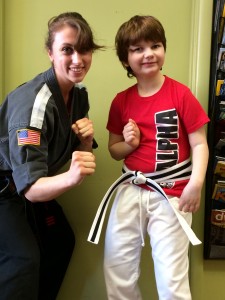Sage Taylor was born with a severe malformation in the right hemisphere of her brain – a condition that caused her to have hundreds of tiny “micro” seizures every day. Here, mom Sam Rosen reflects on their leap of faith with a neurosurgeon at Seattle Children’s and how Sage’s life took a dramatic turn for the better.

In October 2005 my husband Don Taylor and I were blessed with a second daughter. All prenatal tests were normal and my delivery was easy. She was perfect, though more restless than our older daughter and not as good of a sleeper.
Three weeks after Sage came into the world, I was taking a post-partum class for new moms. The nurse instructor took me aside and encouraged me to take Sage to Seattle Children’s as soon as possible for an EEG – a test that measures and records the brain’s electrical activity. She explained she thought Sage had a very slight jerkiness of movement in her arms and legs that might not be normal.
And so began our journey with the incredible doctors and nurses at Seattle Children’s.
On that very day, we took Sage to the hospital’s Emergency Department and learned that she had a wildly abnormal EEG. We were immediately admitted and met Dr. Ray Ferri, an outrageously caring neurologist who followed Sage for the next seven years. After a brain scan, Dr. Ferri looked me straight in the eyes and said, “The right hemisphere of your daughter’s brain is almost completely malformed.”
I was breathless. Sage was diagnosed with cortical dysplasia – a condition where neurons in the brain do not grow together properly, causing the electrical signals that move through those neurons to misfire and cause seizures. I hated to think about it, but my baby was probably having seizures even before she was born – even as early as 16 weeks in utero.
On that same day, Dr. Ferri prescribed phenobarbital, a sedative used to treat epilepsy. The next day we truly met our daughter for the first time. She was clear-eyed and well rested as she’d never been before. For the first time since she was born, we got a glimpse of the real Sage and we prayed medication could stop her seizures.
Unfortunately, Sage’s seizures persisted – even with medication.
Care with compassion
Though her seizures were subtle, I usually knew when one was coming on. Her tiny body would freeze, she’d turn her head, her left arm would stiffen and she’d look away vacantly. It was as if someone was poking my daughter all day long – interrupting her ability to develop into the person she was meant to be.
We were frightened, but we were never alone.
Dr. Ferri was always 100% there for us through many years of overnight EEGs – the right side of Sage’s brain looked like a Jackson Pollock painting and the left side was completely normal – and frequent appointments to tweak this medication or try that one. He was available to us day or night and showed himself to be a true mensch. An amazing human being.
But nothing he did could control Sage’s uncontrollable seizures.
Our last hope
We always tucked away the idea that there was a brain surgery that might work to end the seizures. It was a bridge we knew we would have to consider crossing as a last resort if all else failed.
By summer 2011, Dr. Ferri felt we’d exhausted all medication options and the persistent seizures were affecting our daughter’s growth and development. He believed that surgery to disconnect the tissue between the right and left sides of the brain, known as hemispherectomy, was the right course for Sage, then age 6. If it worked, our daughter could be seizure-free and medication-free for the remainder of her life – and might possibly catch up to her peers in school.
At that point we started talking about the unthinkable. What were we doing? Brain surgery for Sage seemed like sheer madness.
When we met with Dr. Jeff Ojemann, he had 50 of these surgeries under his belt; today, that number is more than 100. He explained that the surgery stops all seizures for about 70% of children, and lessens seizures for another 20%. Though it typically doesn’t create new issues, it probably wouldn’t fix Sage’s existing mobility issues, including being much weaker on her left side. And then, of course, there were risks inherent in any brain surgery, including swelling, loss of peripheral vision and difficulty speaking.
We appreciated Dr. Ojemann’s honesty and his ability to help us make a decision in the face of so much that is unknown about the brain. He instilled confidence and we felt like we were in very capable hands. We decided to sign the papers and move forward with our last hope: the hemispherectomy.
Fear, fear, fear
Two weeks before the surgery my neck was in knots and I couldn’t sleep more than four hours at a clip. I was super anxious and having a hard time breathing. I was just so full of fear.
Sage didn’t really have any idea what was going to happen. I told her that she’d be going to the hospital and doctors were going to try to make her seizures go away. Her response was to hold her head and say “no owww,” meaning that she didn’t want anyone to make her head hurt.
Each time the word surgery was mentioned, Sage said “nooo.” We tried to sell it as a good thing but she wasn’t buying. The hard part for us was that she was so well on so many levels: happy, stubborn, funny, mischievous and more. My heart ached with the thought of possibly losing that, even for a little while. I tried to remember the long-term gain; but…I was so worried for my little girl.
In the days leading up to surgery, Campbell, Sage’s older sister who was 8 at the time, made this post to our blog (using her best spelling and punctuation):
“On monday i pretended to be sick because i’m really scared about my sisters surgery. Though there is 90 precent that it will be fine i am still scared! I hope it will be fine. But i feel good because she will get better.”
The big day arrives
We left Sage asleep with the anesthesiologist and headed to Starbucks and the hospital chapel. We drank endless amounts of coffee during the seven-hour surgery, performed on Dec. 8, 2011. And then Sage emerged. The first thing she said was “done!” in typical Sage fashion. Then she said “dada” and “hey” and promptly fell asleep.
Just a few hours before, Dr. Ojemann had disconnected the right hemisphere of her brain from the left by cutting the electrical nerve pathways between the two sides.
Success!
Two days after surgery, Sage insisted on sitting upright and feeding herself. She ate three meals and her vitals were all within normal range. Dr. Ojemann said an MRI confirmed that they achieved their goal – a clean disconnection (which would hopefully prevent seizure activity from spreading to the left hemisphere of Sage’s brain).
Miracle worker: Dr Jeff Ojemann. Miracle: Sage Nicole Taylor.
Don and I took turns staying with Sage at night. As I was leaving one evening a few days after the surgery, I told Sage I loved her and I’d see her the next morning and she whispered, “I love you, too.” What more could a mommy ask for?
We spent Hannukah and Christmas in the hospital. Santa came by. Therapy dogs visited. Though the hospital staff members and volunteers were wonderful and caring, we all went a little stir crazy.
Ups and downs
As the days passed, Sage’s recovery got bumpier – and I would have gladly traded places with her. She was often cranky and complained of aches in her neck, cheek, head, belly and knee – the result of her brain sending out random pain signals. Major milestones, like taking her first steps again or having a short play session, left her exhausted and sleeping for 16-18 hours at a stretch.
Dr. Susan Apkon on the Rehabilitation Medicine team cared so much about Sage and was a great advocate for us, and the occupational, physical and speech therapists were amazing. We saw them multiple times a day and they really knew how to draw out Sage when she was tired and cranky. They were wonderful.
Sage also got a temporary ventricular drain – a very thin tube inserted into her spine to allow cerebrospinal fluid to drain. Dr. Ojemann explained this was a routine procedure to prevent future issues; luckily, she only needed the drain for five days before her body began to absorb the fluid on its own. (Very few children on Dr. Ojemann’s watch need permanent drains or “shunts,” and his shunt rate is lower than the national average for this type of surgery.)
Through it all I watched in sheer amazement as the left side of her brain started making new connections and her creativity poured out. Dr. Ojemann had hoped the brain function in Sage’s right hemisphere (known for creativity) would re-map to the left side of her brain after surgery – and it did!
A Curious George stuffed animal became her constant companion – the first time in her life that she’d ever had a favorite toy and she began to use her imagination to play with him in ways we’d never seen before. She also started saying words I’d never heard her use. I was finally full of hope for my daughter’s future.
A new life

Three years have passed since Sage’s hemispherectomy and she’s never had another seizure; plus, she’s off all medications. Our magnificent and very funny 9-year-old has truly blossomed: she loves to talk, she’s very creative and she’s making leaps and bounds in her reading, writing and math skills. Physically, the right side of her body will probably always be much stronger than the left, but she can run, do karate, play with her friends and ride a bike made especially for her!
Though we are no longer “regulars” at the hospital, we are permanently grateful to Seattle Children’s. The hospital will be part of our family forever. (A year after the surgery, our beloved neurologist Dr. Ferri told us with a bit of sadness, but mostly gladness, that we really had no reason to see him anymore, unless we just wanted a social visit.)
No one ever signs up to be the parent of a special needs child, but when that is your path you go bravely forward. For all of the parents whose paths will map closely to mine, my hope is that you rely on Seattle Children’s to guide, heal and save, as we did for our precious girl.
Donate now to Seattle Children’s Greatest Needs and help patients like Sage receive the most advanced lifesaving care in our region. To support the work of the Neurosurgery team, please designate your gift to the “Neurosurgery Fund.”
Resources
- Epilepsy Program at Seattle Children’s
- Neurosurgery at Seattle Children’s
- Neurology at Seattle Children’s
- Rehabilitation Medicine at Seattle Children’s

